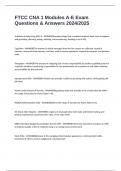FTCC CNA 1 Modules A-E Exam
Questions & Answers 2024/2025
Activities of daily living (ADL's) - ANSWERSEveryday things that a resident routinely does, such as hygiene
and grooming, dressing, eating, toileting, and transferring. Reading is not a ADL.
Cognition - ANSWERSThe manner in which messages from the five senses are collected, stored in
memory, recovered from memory, and later used to answer questions, respond to requests, and perform
tasks
Delegation - ANSWERSThe process of assigning part of one's responsibility to another qualified person in
a specific situation; transferring responsibility for the performance of an activity or task while retaining
accountability for the outcome
Interpersonal skills - ANSWERSA health care provider's ability to get along with others, while getting the
job done
North Carolina Board of Nursing - ANSWERSRegulatory body that provides a list of tasks that fall within
the range of function for Nurse Aides in NC
NCBON Administrative Code - ANSWERSDefines the range of function for Nurse Aides in NC
NC Nurse Aide I Registry - ANSWERSA registry of all people who meet state and federal training and
testing requirements to perform NA I tasks, in the state of NC
OBRA (Omnibus Budget Reconciliation Act) of 1987 - ANSWERSFederal law, enacted by Congress in 1987,
to improve quality of life of residents living in a nursing home environment
Work Ethic - ANSWERSBehavior in the workplace that includes appearance, communication skills,
treatment of others, choices, judgement, and teamwork
, Plan of care - ANSWERSThe NA I may be delegated a task by the RN that is based upon a resident's
__________
Privacy - ANSWERS______ is key when providing basic nursing skills
5 Rights of Delegation - ANSWERSRight task, right circumstance, right person, right direction and
communication, and right supervision and evaluation
Airborne precautions - ANSWERSA transmission based precaution that prevents spread of harmful germs
that travel in the air at a distance, using standard precautions, plus a respirator, depending on the
specific disease (examples include Tuberculosis, chicken pox, measles, legionnaires)
Bloodborne pathogens - ANSWERSHarmful germs found in human blood and can cause infection and
disease
Body fluids - ANSWERSBlood, pus, liquid from sores, urine, stool, tears, spit, droplets from sneezes and
coughs, and sputum
Carriers - ANSWERSPeople who have harmful germs living on or in their body, but are not visibly sick
CDC (Centers for Disease Control) - ANSWERSAn agency the federal government that is in charge of the
control and prevention of disease, in our country
Chain of Infection - ANSWERSInfectious agent, reservoir, portal of exit, mode of transmission, portal of
entry, susceptible host
Contact Precautions - ANSWERSA transmission-based precaution that prevents spread of harmful germs
by direct contact, using standard precautions, plus gown and gloves (examples include MRSA, norovirus)
Droplet Precautions - ANSWERSA transmission-based precaution that prevents spread of harmful germs
that travel by droplets in the air, using standard precautions, plus mask and gloves (examples include
influenza, meningitis, whooping cough)




